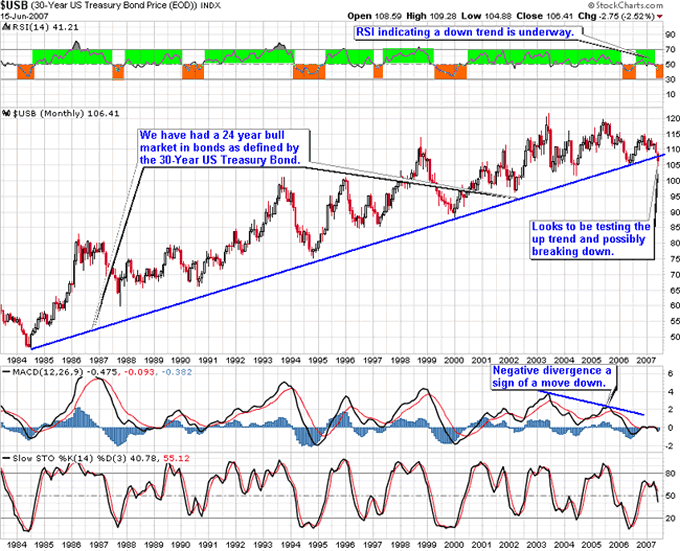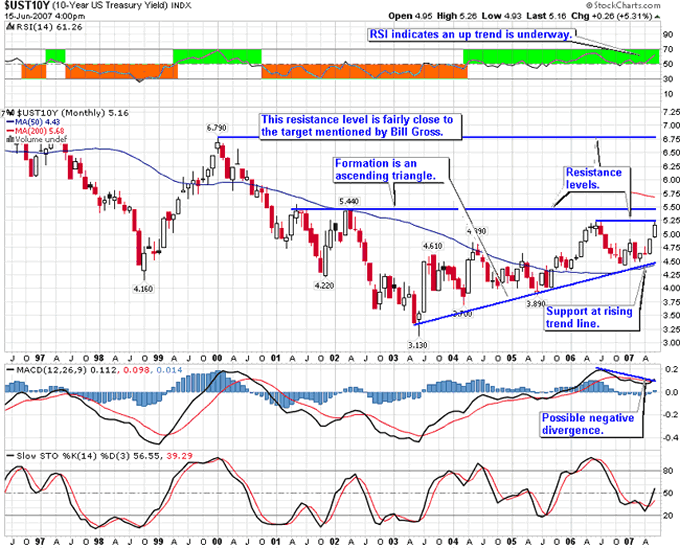Interest Rates Move Stocks
Stock-Markets / Global Stock Markets Jun 22, 2007 - 01:22 PM GMTBy: Hans_Wagner
 Investors seeking to beat the market should be aware of the trends in interest rates. In the last couple of weeks we have seen longer term interest rates with the 10 year U.S. Treasury Note breaking through the 5% level. In response to the most recent rise in interest rates, stock price volatility increased causing investors to become more cautious about the stocks in their portfolios. The question is does this increase in interest rates signal a decline in the stock markets and in the price of stocks? Before answering that question, consider some background on interest rates.
Investors seeking to beat the market should be aware of the trends in interest rates. In the last couple of weeks we have seen longer term interest rates with the 10 year U.S. Treasury Note breaking through the 5% level. In response to the most recent rise in interest rates, stock price volatility increased causing investors to become more cautious about the stocks in their portfolios. The question is does this increase in interest rates signal a decline in the stock markets and in the price of stocks? Before answering that question, consider some background on interest rates.
Who is in the Driver's Seat, Interest Rates or Stock Prices
What affect does interest rates and bond prices have on stock markets and the prices of stocks? Basically, bond investors are more closely aligned with the economy as interest rates are a key determinant of economic performance. Stock investors must be aware of the economy but they focus on companies and their individual performance.
Interest rates and especially changes in interest rates are a major driver of the economy and the stock market. As investors we are very interested in the direction interest rates will go over the next 6 months and year. Unfortunately forecasting the direction interest rates will move is fraught with failure. Typically, for every forecast of increasing rates by economists there is another forecast of decreasing rates. So what are investors to do?
Well, it turns out that interest rates are much more volatile that most investors realize. Ed Easterling of Crestmont Research found out that in the past 35 years (with a 2-month exception), there has not been a 6-month period during which interest rates somewhere along the yield curve did not change at least 50 basis points. More than half of the time, interest rates change by more than 1.5% (and over 25% in percentage terms) over all 6-month periods. Now that is something we can use, so let's examine the current state of interest rates in a little more detail.
State of Interest Rates
Bill Gross of Pimco Bonds, the world's largest bond management firm, stated in his most recent investment outlook that “With the possibility of creeping inflationary tendencies, especially in weak currency countries including the U.S., combined with the potential reduction of financial flow subsidies which to this point have favored fixed income vs. equity and real commodity investments, we come to the following range forecasts for the secular timeframe from 2007 to 2011.”

Source: Pimco Bonds Investment Outlook May/June 2007
While not the only cause of the rise in the 10 year U.S. Treasury rate, Bill's comments are closely followed. Rising rates are further evidence that the Federal Reserve will not be lowering rates in the next six months.
The chart below shows the 24 year bull market in 30 year US treasury Bonds. This is the chart of bond prices not interest rates. Remember bond prices move in opposite direction to interest rates. As indicated, it looks like this could be coming to an end. If this happens then Bill Gross's comments would be confirmed and we are much more likely entering a period of higher rates.

The chart below is of the 10 Year US Treasury Yield. It shows that rates are rising and testing resistance levels. On the chart the 5.25 and the 5.44 areas are important near term resistance. In addition the high of the last ten years is quite close to the target mentioned by Bill Gross. Kind of interesting.

What Stock Investors Should do Now
So what does this mean for stock investors today? First we need to assume that interest rates are more likely to move up than down for now. That means that companies that are more sensitive to rising interest rates should be avoided, such as REIT and utilities.
In theory, rising interest rates should be good for stocks. If the economy is growing too rapidly then corporate earnings should also be growing rapidly and so should stock prices. In reality, rising rates are often bad for stocks, for several reasons:
- When rates go up, investors who had been buying stocks opt for bonds because their yields are rising.
- The market looks ahead. Stocks rise when investors think the economy and corporate earnings will grow. When the Federal Reserve increases rates, it is seeking to restrain the economy.
- Companies that borrow money pay more when interest rates go up. This reduces their earnings.
- Consumers also pay more to borrow money, which discourages them from buying cars, houses and everything that goes with them. This hurts companies dependent on the consumer.
By Hans Wagner
tradingonlinemarkets.com
My Name is Hans Wagner and as a long time investor, I was fortunate to retire at 55. I believe you can employ simple investment principles to find and evaluate companies before committing one's hard earned money. Recently, after my children and their friends graduated from college, I found my self helping them to learn about the stock market and investing in stocks. As a result I created a website that provides a growing set of information on many investing topics along with sample portfolios that consistently beat the market at http://www.tradingonlinemarkets.com/
Hans Wagner Archive |
© 2005-2022 http://www.MarketOracle.co.uk - The Market Oracle is a FREE Daily Financial Markets Analysis & Forecasting online publication.


